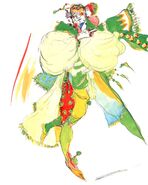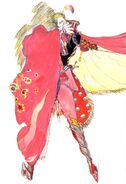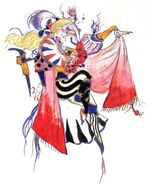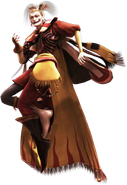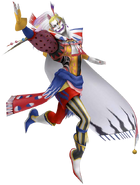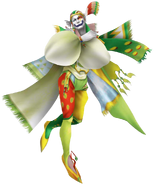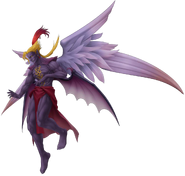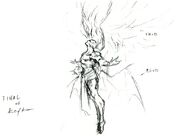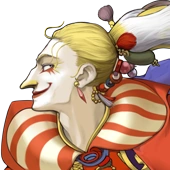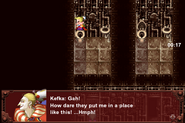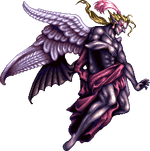Template:Sideicon Template:Character
Read my lips—mercy is for wimps! There's a reason 'oppose' rhymes with 'dispose'...If they get in your way, kill them!
Kefka Palazzo
Kefka Palazzo (spelled as Cefca Palazzo in the Japanese version), is the main antagonist of Final Fantasy VI. The prototype to the Magitek Knights, Kefka acts as Emperor Gestahl's court mage carrying out his orders, but behind his back schemes for his own ends.
While previous antagonists in the Final Fantasy series were distant, cold, ruthless, and bent on their goals, Kefka is loud, short-tempered, maniacal, and destructive. His popularity among Final Fantasy fans, at least outside Japan, as an antagonist is rivaled only by Sephiroth from Final Fantasy VII. Kefka is known for his many one-liners, his final almighty appearance (which has become something of a tradition in the series), as well as his sociopathic hatred of everything in existence. Kefka's defining character trait is his laughter, a high-pitched whooping cackle. In large part because of his dark humor and jester attire, Kefka was also given the nickname "the psycho clown" by fans, with this eventually becoming official with his CollectaCard description in Theatrhythm Final Fantasy.
Profile
Appearance
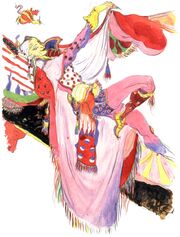
Artwork by Yoshitaka Amano.
Ever outlandish, Kefka resembles a jester or clown. In his original concept artworks, and in Dissidia Final Fantasy, Kefka wears an outfit composed of primarily red and yellow fabrics, a mismatched jumble of stripes and polka dots. He wears a red and white striped ruffle around his neck and a red cloak with a yellow and red inner lining. In his field sprite in the original Final Fantasy VI, as well as alternate artworks and, to a lesser extent, an alternate costume in Dissidia 012 Final Fantasy, Kefka wears green robes with gold linings and red clothing. In his field sprite for the mobile and Steam rereleases, he has a white and red ruffle, purple boots, red clothing, and a brown robe with green fabrics and gold linings.
Kefka's face and hands are covered with white make-up, and he has red eye shadow. However, due to graphic limitations, his field sprite in both the SNES/PSX/GBA releases and the iOS/PC releases has his face and hands having the same skin color as most of the other human characters, save for red splotches below his eyes. His blond hair is tied into a tight ponytail, accentuated by an extending feather. In Dissidia Final Fantasy, his appearance is altered slightly, with Kefka gaining a wide grin resembling a Glasgow smile accentuated in purple make-up as well as having pointed ears. His height was listed as 5'4" for Final Fantasy VI, but he appears taller in Dissidia. In the original Final Fantasy VI, Kefka's sprite gave him slightly gray hair, presumably in an attempt to make him look dirty blonde. In the iOS/Steam rereleases, however, his hair color was explicitly depicted as blonde in the field sprite.
In his "god" form, Kefka is a demonic angel with purple skin and a red loincloth. His limbs become more muscular and he bears six wings—four light, angelic wings and two dark, bat-like wings (although the Final Fantasy Anthology model replaces the bat-like wings with light angelic wings). In this form, the only resemblance Kefka retains to his human self is his ponytail, which is longer, with strands flowing upwards, and the feather that remains in his hair as a final reminder of Kefka's once-extravagant dress sense. Similar to his standard appearance, his god of magic form's appearance in Dissidia is altered slightly by giving him gold, curved, vein-like markings on his chest as well as his shoulder blades jutting out of him, in addition to a Glasgow smile.
Personality
Hee-hee-hee! But what's the fun in destruction when there are no 'precious' lives lost?
Kefka
Although initially Kefka seems lighthearted, his true nature is maniacal, short-tempered, flamboyant, destructive, and cruel. This is a result of him having been made into a Magitek Knight. He is a psychopath with no regard for human life nor remorse for the atrocities he commits, and revels in the suffering of others. He cracks dark jokes, breaks out into hysterical laughter upon causing mayhem, and his only joy is causing senseless destruction, death and chaos. Kefka doesn't even consider destruction fun unless lives are lost in the process. His bio in Dissidia 012 Final Fantasy states he lacks self-control. He is ruthless, as evidenced by his briefing to his soldiers during their march to Narshe. Despite his insanity he is high-functioning enough to plot to access the Warring Triad and to betray his liege. He has no qualms with murdering many of his own men even for trivial reasons. It is implied Kefka is hated and feared by many Imperial soldiers for this reason.
When the Returners infiltrate the Magitek Research Facility Kefka claims he is all-powerful, and intends to become a god, suggesting he suffers from megalomania. After becoming a god he boasts the Returners have no chance against him. According to the Final Fantasy VI creation guide, he is narcissistic, being fascinated with the image in the mirror and dressing up for mirrors. This is implied in Dissidia with Kefka's mirror match quotes being compliments on the other Kefka's appearance. Kefka is a manchild, referring to fighting as "playing" and treating Terra as a doll to be toyed with. In the Japanese versions of Final Fantasy VI and Dissidia Final Fantasy, Kefka frequently uses the first-person pronoun boku-chin when referring to himself, a pronoun usually reserved for young boys, with small hints of this being shown in the localized version via him throwing tantrums at various points in the game. The Dissidia series also hints at his having crossdressing tendencies.
Kefka is characterized somewhat differently between the Japanese and international releases of Final Fantasy VI. In the former, his childish nature is emphasized, while in the western releases, he is depicted in a darker manner, shown knowing and enjoying the pain and suffering he inflicts on others.
What begins as a disregard to human life develops into nihilism, and at the end of Final Fantasy VI Kefka declares the lives of mortals insignificant finding no meaning in things like love and hope, and seeks to destroy the bonds of existence itself. He finds the concepts of love and hope nauseating, and finds the Returners' examples of finding meaning for life in a ruined world sickening. He has a similar reaction in Dissidia, when he, deducing that Terra and Onion Knight are still friends after their battle, declares that it makes him "want to puke [his] guts out."
Dissidia Final Fantasy shows a more tragic view of Kefka's insanity. Once he is defeated in Shade Impulse, Kefka laments on the futility of life in a soliloquy mirroring his speech in Final Fantasy VI, and fades with a sad laughter. Terra speculates Kefka destroys to fill his broken heart. In Dissidia 012 Final Fantasy before the battle, she wonders if Kefka is being tormented when he repeatedly chants "destroy". Kefka's Dissidia 012 Final Fantasy Museum profile mentions he self-destructed to make himself feel better. This depression relating to his nihilism and being incapable of understanding means other than destruction to give meaning to life was hinted at in the original game when the Returners state what they hold on to to persevere in the World of Ruin. Kefka briefly pauses, as if sad, before ranting that he'll get rid of all dreams.
Abilities
Kefka's god form in an FMV (Anthology).
Kefka grows more powerful as the story progresses. He attacks Sabin in the Imperial Camp with a simple Morning Star, and could be injured by any attack (although he remarks after the second battle he was holding back). In Narshe, he knows strong spells for that point in the game, but they are overall weak in the scope of the entire spell list—his strongest spell at this time is Blizzara.
Kefka acquires more power by absorbing the espers' strength, and by the time he arrives in Thamasa, he can project illusions, single-handedly kill dozens of espers while being immune to their powers, and presumably can use Banish. He can disable the espers' powers, an ability implied to result in the destruction of anyone in close proximity, as evidenced by the disappearance of the three Magitek Armor troopers who accompany him when he uses it. He is still vulnerable at this point, as Celes stabs him aboard the Floating Continent, although he seems more angry than hurt.

FMV concept for Kefka's god form.
Following his taking control over the Warring Triad, Kefka becomes the God of Magic and his strength increases exponentially. He exploits the abilities of warping reality: elemental manipulation, power bestowal, and magical absorption. He utilizes telekinesis, and can project a pyramid-shaped magical field around him, although it is not specified whether it is intended to be a magical barrier, or a projection of his power. Now knowing the most powerful magical attacks, including Ultima, Kefka levitates debris from around the world to form his tower. He uses Light of Judgment to smite those who do not acknowledge his rule, and at least half a dozen towns are devastated (although he at one point implies that he often smites people simply because he finds it fun).
Kefka creates various new monsters to guard his tower, including the revived, but weakened, Warring Triad themselves. Kefka creates a new spell called Forsaken, (known as "Goner" in the original U.S. SNES release) his signature attack with a magic power of 220, the highest in the game. However, Forsaken does not ignore defense, limiting its potential power. Kefka can use his wings for offense, appropriately referred to as Havoc Wing. In Dissidia Final Fantasy Kefka can use Havoc Wing in his regular form in addition to his god form, although he needs to partially transform into his god form to sprout the wings. He can summon angels to sap others of their strength, called Heartless Angel.
Story
Template:Sideicon
Early life
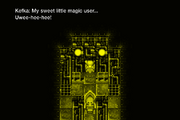
Kefka controlling Terra.
Kefka is thirty-five years old and Emperor Gestahl's right-hand man. At least sixteen years ago Kefka was the first experimental Magitek Knight, which gifted him magical power, but shattered his sanity as the process had not been perfected yet.[1] Kefka became a cruel, destructive madman, and acquired a reputation as one of the most dangerous men in the Gestahlian Empire. About six years after the procedure, the imperial military was restructured with Kefka and Leo Christophe being involved. Kefka used a slave crown to control Terra Branford—a half-human half-esper girl the emperor had kidnapped from the Esper World when she was but a baby who can use magic naturally. As a test of whether its enslaving effects were effective, Kefka had her burn fifty imperial soldiers alive.
The empire

Kefka in a FMV from Final Fantasy VI (Anthology).
Hee, hee! Nothing can beat the sweet music of hundreds of voices screaming in unison!
Kefka, about to poison Doma's river
Kefka sends Terra to Narshe to acquire the recently discovered frozen esper, Valigarmanda, sending Biggs and Wedge with her. Espers are magical beings who were thought to have become extinct long ago, and with them, magic use fell into legend. The mission fails when Valigarmanda awakens, dispatches Biggs and Wedge, and damages the slave crown, restoring Terra's free will but leaving her with amnesia.
Kefka comes to Figaro Castle seeking Terra under orders from Gestahl and presumably as part of a reconnaissance mission. He complains about Figaro's location amid a desert and makes his soldiers wipe his boots from sand. King Edgar, who is sheltering Terra in the hopes she will join the Returners against the empire, conceals her whereabouts. Kefka doesn't believe Edgar and sets the castle on fire. When the castle burrows under the desert, Kefka has his bodyguards attack the fleeing Edgar, Terra and Locke Cole. The trio dispatches them and leaves Kefka fuming.
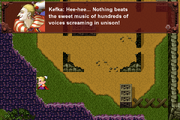
Kefka poisoning the river.
Kefka comes to the kingdom of Doma as part of a battalion led by General Leo Cristophe. It is rumored Kefka will replace Leo as the general of the imperial military, to which at least one soldier declares he'd quit if Gestahl ever let it happen. Although Leo wants to win the siege with minimal casualties, Kefka plots to poison the river and kill the castle's population. After Leo is called away by Emperor Gestahl, Kefka orders the imperials to dump the poison. One soldier is reluctant as there are captured imperials within the base, and Edgar's brother Sabin and his assassin accomplice Shadow attempt to stop him. Kefka dumps the poison himself, killing everyone in the castle except for Cyan Garamonde and a Doma Sentry, all the while musing about the music of the unified screams of hundreds of voices.
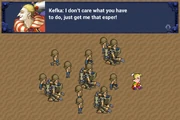
Kefka going to Narshe with his army.
As the Returners reunite in Narshe, Kefka leads an imperial force to the clifftops above Narshe to claim Valigarmanda. Kefka persuades his reluctant forces to slaughter everything to get the esper, but the Returners guard it and, after fighting off his troops, confront Kefka. Defeated, Kefka flees, but swears revenge.
Terra, who has joined the Returners after escaping her predicament as a tool for the empire, confronts Valigarmanda, and is transformed into an esper herself and flies off. Tracking her down, the Returners meet the esper Ramuh, who tells them the true source of magic: magicite, an esper's remains, which can teach magic at a higher concentration than Magitek, the magic technology the empire had devised to project its power and take over the world. The Returners use Setzer Gabbiani's airship, the Blackjack, to fly to Vector and release the espers imprisoned by the empire they had captured during their raid of the Esper World many years ago.
Acquisition of power
I'm a god! I'm all-powerful! Uwee-hee-hee... I'll collect more espers! I'll extract their magic... And then... ... ... I'll revive the Warring Triad!
Kefka in the Magitek Factory.
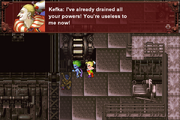
Kefka dumping Shiva and Ifrit.
Within the Magitek Research Facility the Returners spy Kefka torturing espers and overhear him cackling over the power he has gained from them and his plans to restore the Warring Triad. After entering the heart of the facility and retrieving the magicite of the dead espers, the Returners meet the Imperial scientist Cid, who realizes the true source of esper energy. Kefka, overjoyed to learn this, attempts to have Celes, a former imperial general turned Returner, hand the pieces of magicite over to him. Celes spirits herself and Kefka away so the Returners can escape, although not before Kefka hints that she is a spy under the employ of the empire making the Returners doubt her intentions. As the Returners flee the continent, Kefka activates two large cranes in the Imperial Palace to attack the Blackjack.
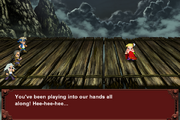
Kefka follows the Returners to the Sealed Gate.
With Terra aware of her origins as a half-human, half-esper hybrid, she and the Returners go through Cave to the Sealed Gate to the Esper World to secure their support for an attack on the empire. Kefka follows and declares that Gestahl has told him to let Terra ally with the Returners to have them open the gate, as its sealing during the empire's first raid on the realm many years ago was what prevented them from advancing. Kefka is defeated when the espers emerge from the gate and Gestahl has Kefka imprisoned in Vector as a ploy to earn the Returners' trust so they would ally with him to find the escaped espers.
Ascension to godhood
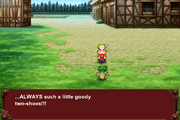
Kefka kills Leo.
And time will destroy all of those as well. Why do people insist on creating things that will inevitably be destroyed? Why do people cling to life, knowing that they must someday die? ...Knowing that none of it will have meant anything once they do?
Kefka upon the Returners confronting him at his tower, regarding life and existence.
Gestahl releases Kefka and he is dispatched to Thamasa where he has his soldiers attack both the Returners and General Leo's troops before killing the espers and taking their magicite remains. When Kefka orders his troops to burn the town, General Leo steps in, but Kefka slays him and projects an illusion of Emperor Gestahl who "admits" he set Leo up to allow the empire acquire more espers. Kefka explains he'll cover up the murder by claiming he disposed of a traitor.
The Sealed Gate rips open and a wave of espers flies into the village to attack Kefka, but he has grown too strong and the espers' attacks have no effect. Kefka slays them with his magic and takes their magicite shards.
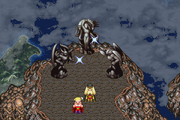
Kefka and Gestahl in front of the Warring Triad.
The gate between the realms open, Kefka and Gestahl cross over to the Esper World, find the Warring Triad, and raise the Floating Continent. The Warring Triad are the remains of three petrified deities who had tasked the espers, beings who can wield the gods' magic, with sealing them away to another realm. When Kefka and the emperor reach the statues they react and the Land of Espers rises out to the sky and becomes the Floating Continent.
When the Returners confront the two, Kefka orders Celes to strike the Returners down to prove her loyalty to the empire. Celes stabs Kefka instead, and an enraged Kefka rushes into the field of the Triad and demands they unleash their full power. Ignoring Gestahl's warnings, being shielded from Gestahl's attacks via the Triad's magical field, Kefka has the statues strike the emperor down and pitches his body off the edge of the floating island. Kefka, shoving Celes to the side when she attempts to stop him, moves the Triad out of alignment, shattering their delicate magical field, but ends up pinned by Shadow between two of the statues. Shadow and the Returners narrowly escape, but the damage is done; the World of Balance shifts into the World of Ruin.
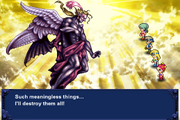
The party confronts Kefka.
After the end of the world Kefka drains the Triad of their power, turning them into weakened husks and himself into a god. Kefka builds a tower from the rubble of the world he had destroyed, and from there rules by smiting anyone who dares defy him with the Light of Judgment: a beam of magical energy that can destroy entire towns. A cult rises, worshiping Kefka (likely out of fear more than anything else). Kefka creates numerous new monsters to guard his tower should anyone rise up against him.
Death

The tiers of monsters atop Kefka's Tower leading to him.
Life... dreams... hope... Where do they come from? And where do they go...? Such meaningless things... I'll destroy them all!
Kefka during the final battle.
A year after the end of the world, Celes awakes on a deserted island and journeys to reunite the scattered Returners who assault Kefka's Tower. Atop it he reveals he views life as meaningless and destruction as inevitable. The Returners deny his claims by citing how, despite the world being in ruin, they have found hope on which to hold. Kefka finds their examples sickening and decides to destroy everything, even the essence of life itself. He explains he found destruction fun precisely because precious lives are lost in the process. He raises a gnarled pillar filled with effigies of himself, and when the Returners confront Kefka in a golden skyscape, he laughs maniacally as he states he'll destroy everything.
Kefka is killed, but since he had become the God of Magic, magic vanishes from the world with him. Though the espers and their remains are destroyed, Terra, due to her connection with the children of Mobliz, is spared, and becomes a human. Kefka's Tower collapses and peace is restored unto the world.
Gameplay
Kefka appears on five separate occasions as a boss. On two occasions he is fought as a normal boss, on two others he is a cinematic enemy, and his final appearance is as the final boss. Kefka knows most high level Magic abilities, which he uses on the party.
Additionally, several dummied stats for Kefka exist. A dummied enemy named "Kefka", without Kefka's sprites, appears within the file. There are also many dummied stats and equipment given for Kefka as a party member, even if he was not meant to be playable. He cannot be hacked into the party, as the game will freeze when it is his turn.
Musical themes
Template:Listen "Kefka" plays frequently during the first part of the game and during the party's confrontation with him before the final battle. The theme begins with a light, bouncing beat using wind and string instruments, until the background drumbeats and cymbals become more prominent and the theme becomes louder and more dramatic, perhaps a reflection of Kefka's rise to power or his further descent into insanity.
Although not a theme for Kefka himself, "The Fanatics" plays in the Cultists' Tower, featuring drumbeats and synthesized low male vocalizations (female vocalizations in the TOSE rendition), and plays as the Returners confront Kefka at the top of his tower.
"Dancing Mad" plays during the final battle. One of the longest musical scores in the series, depending on how many times each section is repeated, a remix of "Dancing Mad" by The Black Mages runs for just over twelve minutes—other remixes are even longer. The music is divided into four sections, one for each tier of the final battle. The piece includes remixes of "Kefka", as well as themes from throughout the game. In some official remixes, such as the Distant Worlds rendition, the synthesized vocals are replaced with actual vocals in Latin. The lyrics allude to Kefka's role in destroying the world and his insanity.
Creation and development
According to Final Fantasy VI director Yoshinori Kitase, the scene where Kefka has his accompanying soldiers dust off his shoes was ad-libbed into the script, as he felt the original introduction scene was too boring. He wrote it to give the players an early implication that Kefka had a few screws missing.[2]
Voice
Kefka's English voice actor is Dave Wittenberg, who also voices Yazoo in Final Fantasy VII: Advent Children, Amodar in Final Fantasy XIII, and Captain Cryptic in Final Fantasy XIII-2. Wittenberg voiced him with a high-pitched, comical, bouncy, cheerfully deranged tone that occasionally drops down to an intimidating growl.
In the Japanese versions, Kefka was voiced by Shigeru Chiba, who also voices Valkus in the OVA Final Fantasy: Legend of the Crystals and Provost Zaido Tekise in Final Fantasy Agito and Final Fantasy Type-0.
Template:Listen Kefka is known for his high-pitched trademark cackle. Kefka laughs often but usually only cackles prior to significant plot events. As the game progresses the laughter is remixed slightly, and in the final battle is extended to almost five seconds at the start of the battle, and the normal laughter is frequently repeated during the rest of the fight. Kefka's trademark cackle is incorporated into the "Dancing Mad" track, and is audible just before the track begins to loop.
In Final Fantasy VII the player can hear a lower, slowed-down version of Kefka's signature laugh if they go to the Ghost Square at the Gold Saucer and inspect a "face" in the corner of the item shop. They can also hear this laugh when Tifa and Cloud fall in the Lifestream, at Mideel. Kefka's laugh also appears in Square's Chrono Trigger when the player talks to Nolstein Bekkler in the Millennial Fair. The player can also hear it from Ozzie. Zalera, one of Final Fantasy XII Espers, uses a remake of Kefka's laugh in his final attack, Condemnation. On the theme "Unavoidable Battle" from Final Fantasy Tactics, the tune of the intro is the same as the tune of Kefka's laugh.
Other appearances
Kefka has made appearances in the following games in the Final Fantasy series:
- Final Fantasy Tactics S as a playable character.
- Final Fantasy Dimensions II as a summon.
- Dissidia Final Fantasy as a playable character.
- Dissidia 012 Final Fantasy as a playable character.
- Dissidia Final Fantasy NT as a playable character.
- Dissidia Final Fantasy Opera Omnia as a playable character.
- Theatrhythm Final Fantasy as a playable character.
- Theatrhythm Final Fantasy Curtain Call as a playable character.
- Theatrhythm Final Fantasy All-Star Carnival as a playable character.
- Pictlogica Final Fantasy as a playable character.
- Final Fantasy Airborne Brigade as a summonable Legend.
- Final Fantasy Artniks as a series of cards.
- Final Fantasy All the Bravest as a playable character.
- Final Fantasy Record Keeper as a playable character.
- Final Fantasy World Wide Words.
- Final Fantasy Brave Exvius.
- Final Fantasy Trading Card Game as a series of cards.
Non-Final Fantasy guest appearances
Kefka has made key guest appearances in the following non-Final Fantasy games:
- Itadaki Street series as a playable character.
- Lord of Vermilion series.
- Puzzle & Dragons as an obtainable character and an enemy boss.
Other media
Games
In The Elder Scrolls III: Morrowind, there is a dungeon called the "Kefka Burial".
Merchandise
A toy based on Kefka's god form has been released in the Final Fantasy Master Creatures series. It bears the name Cefca Palazzo. It depicts Kefka's final boss form floating above the swirling yellow mist. His standard appearance later appeared as part of Volume 5 of the Creatures KAI series.
Gallery
Etymology and symbolism
"Kefka" may derive from Kurt Koffka, a German psychologist who worked on the Gestalt psychology. Another possibility is Franz Kafka, known for his stories based around hopelessness whose writings are considered existentialist.
"Palazzo" is a common last name of Italian descent and means "palace", "mansion", or "castle". The word can also be cut to the adjective pazzo, the equivalent of "insane". Its pronunciation is similar with the word palhaço, which means "clown" in Portuguese.
The Italian term pagliaccio (pronounced: pa-llià-tcho) for clown, bears a possibly intentional resemblance to Kefka's surname and fit his distinctive clothing.
Kefka's God of Magic form resembles the fallen angel Lucifer, also known as Satan. The similarity was further alluded to with the SNES translation for one of his attacks, Fallen One, one of the names for Lucifer. Additionally, the three stages of his Statue of the Gods first place him in the role of Satan as he appears in Dante Alighieri's Inferno, before having him sequentially mock both Purgatory and Michelangelo's Pietà and at last appear in his final angelic form.
In the 2015 Dissidia arcade game, Kefka's default player name is "nameless madcap". A madcap is slang for someone who is insane, and when used as an adjective indicates that a particular object was eccentric in nature.
Trivia
- Kefka was named the third greatest villain in a video game by Nintendo Power in their 250th issue. The Spanish web Meristation named Kefka the second greatest villain in the history of video games.
- In earlier versions of Final Fantasy VI, before the player fights Kefka, he says "Life... hope... dreams? Where do they come from? And where are they going?" This is similar to the title of one of Paul Gauguin's most famous paintings, Where Do We Come From? What Are We? Where Are We Going?
- A variation of the above quote was used in the Halloween event for Final Fantasy XIV in 2011: "Life...Dreams...Imps... Where do they come from? And where do they go?" This was one of many lines indicating that an Imp had spawned for players to interact with in town.
- Although Kefka's stance as a Magitek Knight is implied in the story, it is never directly stated via normal gameplay. The player must talk to a patron at Vector's pub after avoiding getting caught by the patrolling soldiers to find this out explicitly.
- Kefka's role is foreshadowed in the prologue where he briefly descends from the Imperial Palace at Vector in the part where the narration states "Yet there now stands one who would reawaken the magic of ages past, and use its dread power as a means by which to conquer all the world...".
- According to Tabata, Kefka's wardrobe acted as a partial inspiration for the wardrobe choice for the Final Fantasy XV main antagonist Ardyn Izunia, in particular how their outfits relate to their characterizations.[3]
References
- ↑ Vector citizen: Here's one for you... That guy Kefka? He was Cid's first experimental Magitek knight. But the process wasn't perfect yet. Something snapped in Kefka that day...
- ↑ http://www.1up.com/do/blogEntry?bId=9002538&publicUserId=6049935
- ↑ https://www.gamespot.com/articles/15-new-things-we-learned-from-final-fantasy-15s-di/1100-6436138/
Template:FFVI










